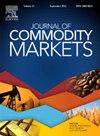U.S. climate policy uncertainty shocks and the growth in renewable energy production
IF 4.5
4区 经济学
Q1 BUSINESS, FINANCE
引用次数: 0
Abstract
Investment in renewable energy production has been subject to swings in the U.S. policy stance on climate change creating uncertainty. Determining how and to what extent the renewable energy sector responds to climate policy uncertainty is relevant to understanding the energy transition from fossil fuels to renewables. This study examines the relationship between the growth in renewable energy production and its sub-components and climate policy uncertainty while accounting for oil price uncertainty and the growth in oil prices, industrial production, and carbon emissions, respectively. Utilizing generalized impulse response analysis within a vector autoregressive model framework, we find that total renewable energy production responds negatively to shocks to climate policy uncertainty but exhibits only a small positive response to oil price uncertainty. Further examination of renewable energy production by its sub-components (i.e., hydropower, biomass, geothermal, wind, and solar) shows that the time path responses to uncertainty shocks differ by sub-component. The findings suggest that policies to facilitate an energy transition by treating renewables similarly may not have the desired effects and thus should be tailored to individual sub-components to achieve targeted goals for renewable energy production.
美国气候政策的不确定性冲击和可再生能源生产的增长
可再生能源生产的投资一直受到美国气候变化政策立场摇摆的影响,造成了不确定性。确定可再生能源部门如何以及在多大程度上应对气候政策的不确定性,与理解从化石燃料到可再生能源的能源转型有关。本研究考察了可再生能源生产及其子成分的增长与气候政策不确定性之间的关系,同时分别考虑了油价的不确定性以及油价、工业生产和碳排放的增长。利用向量自回归模型框架内的广义脉冲响应分析,我们发现可再生能源生产总量对气候政策不确定性的冲击呈负响应,但对油价不确定性仅表现出微小的正响应。对可再生能源生产的子成分(即水电、生物质能、地热、风能和太阳能)的进一步研究表明,对不确定性冲击的时间路径响应因子成分而异。研究结果表明,通过类似对待可再生能源来促进能源转型的政策可能不会产生预期的效果,因此应该针对单个子组件进行定制,以实现可再生能源生产的目标。
本文章由计算机程序翻译,如有差异,请以英文原文为准。
求助全文
约1分钟内获得全文
求助全文
来源期刊

Journal of Commodity Markets
Multiple-
CiteScore
5.70
自引率
2.40%
发文量
53
期刊介绍:
The purpose of the journal is also to stimulate international dialog among academics, industry participants, traders, investors, and policymakers with mutual interests in commodity markets. The mandate for the journal is to present ongoing work within commodity economics and finance. Topics can be related to financialization of commodity markets; pricing, hedging, and risk analysis of commodity derivatives; risk premia in commodity markets; real option analysis for commodity project investment and production; portfolio allocation including commodities; forecasting in commodity markets; corporate finance for commodity-exposed corporations; econometric/statistical analysis of commodity markets; organization of commodity markets; regulation of commodity markets; local and global commodity trading; and commodity supply chains. Commodity markets in this context are energy markets (including renewables), metal markets, mineral markets, agricultural markets, livestock and fish markets, markets for weather derivatives, emission markets, shipping markets, water, and related markets. This interdisciplinary and trans-disciplinary journal will cover all commodity markets and is thus relevant for a broad audience. Commodity markets are not only of academic interest but also highly relevant for many practitioners, including asset managers, industrial managers, investment bankers, risk managers, and also policymakers in governments, central banks, and supranational institutions.
 求助内容:
求助内容: 应助结果提醒方式:
应助结果提醒方式:


